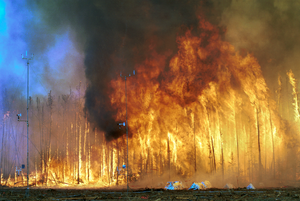
Terrestrial ecosystems found in the boreal (or taiga) regions of North America and Eurasia cover 17% of the Earth's land surface, and contain more than 30% of all carbon present in the terrestrial biome.[1] In terms of carbon storage, the boreal region consists of three ecosystems: boreal forest, peatland, and tundra. Vast areas of the globe and are contributing greatly to atmospheric carbon release due to increased temperature and fire hazard. High northern latitudes will experience the most significant increase in warming on the planet as a result of increased atmospheric greenhouse gases thus placing in jeopardy the carbon sink in these areas. In addition to the release of carbon through the melting of permafrost, high intensity wildfires will become more common and thus contribute to the release of stored carbon. This means that the boreal forest and its fire regime is becoming an increasingly more significant factor in determining the global carbon budget.
Boreal forests are also important economic factors in Russia and Canada specifically, and the uncertainty of fire patterns in the future as a result of climate change is a major consideration in forest management plans. A decrease in allowed timber harvest could be a solution to long term uncertainty of fire cycles.[2]
- ^ Kasischke, Eric S. (2000). "Boreal Ecosystems in the Global Carbon Cycle". Fire, Climate Change, and Carbon Cycling in the Boreal Forest. Ecological Studies. Vol. 138. pp. 19–30. doi:10.1007/978-0-387-21629-4_2. ISBN 978-1-4684-9532-4.
- ^ Daniel, Colin J.; Ter-Mikaelian, Michael T.; Wotton, Mike B.; Rayfield, Bronwyn; Fortin, Marie-Josée (2017). "Incorporating uncertainty into forest management planning: Timber harvest, wildfire and climate change in the boreal forest". Forest Ecology and Management. 400. Elsevier B.V.: 542–554. Bibcode:2017ForEM.400..542D. doi:10.1016/j.foreco.2017.06.039.